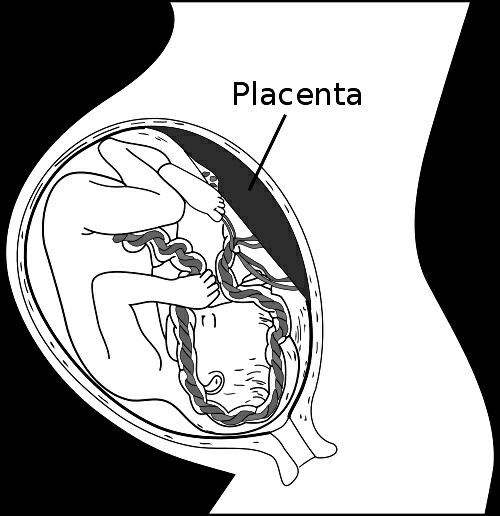
How does the embryo get nourishment inside the mother’s body?
Answer
586.5k+ views
Hint: The embryonic membranes, allantois, and chorion of the fetus develop a connection between the umbilical cord and the mother's uterine cavity. It helps in the exchange of all nutrients, gases, and waste products.
Complete answer:
The embryo grows inside the mother’s womb and gets nourishment from the mother’s blood through the tissue called the placenta. The placenta is a temporary organ that connects the developing fetus to the uterine cavity of the mother via the umbilical. It facilitates the uptake of nutrients and the exchange of gases and waste products from the fetus to the mother. It also helps in regulating the body temperature of the fetus.
Additional Information:
Humans have a chorioallantoic placenta that forms from the chorion and allantois. In humans, the placenta is approximately 22 cm in length and weighs approximately 500 grams. It has a dark reddish-blue or crimson color. It connects to the fetus by an umbilical cord of approximately 55–60 cm in length, which contains two umbilical arteries and one umbilical vein.

Note: Numerous pathologies can affect the placenta like-
1. Placenta accreta- It is caused by the deep plantation of the placenta into the wall of the uterus.
2. Placenta praevia- It is caused by the placement of the placenta in such a way that either it is too close to the cervix or blocks the cervix.
3. Placental abruption- The premature detachment of the placenta is known as placental abruption.
Complete answer:
The embryo grows inside the mother’s womb and gets nourishment from the mother’s blood through the tissue called the placenta. The placenta is a temporary organ that connects the developing fetus to the uterine cavity of the mother via the umbilical. It facilitates the uptake of nutrients and the exchange of gases and waste products from the fetus to the mother. It also helps in regulating the body temperature of the fetus.
Additional Information:
Humans have a chorioallantoic placenta that forms from the chorion and allantois. In humans, the placenta is approximately 22 cm in length and weighs approximately 500 grams. It has a dark reddish-blue or crimson color. It connects to the fetus by an umbilical cord of approximately 55–60 cm in length, which contains two umbilical arteries and one umbilical vein.

Note: Numerous pathologies can affect the placenta like-
1. Placenta accreta- It is caused by the deep plantation of the placenta into the wall of the uterus.
2. Placenta praevia- It is caused by the placement of the placenta in such a way that either it is too close to the cervix or blocks the cervix.
3. Placental abruption- The premature detachment of the placenta is known as placental abruption.
Recently Updated Pages
A man running at a speed 5 ms is viewed in the side class 12 physics CBSE

State and explain Hardy Weinbergs Principle class 12 biology CBSE

Which of the following statements is wrong a Amnion class 12 biology CBSE

Two Planoconcave lenses 1 and 2 of glass of refractive class 12 physics CBSE

The compound 2 methyl 2 butene on reaction with NaIO4 class 12 chemistry CBSE

Bacterial cell wall is made up of A Cellulose B Hemicellulose class 12 biology CBSE

Trending doubts
What are the major means of transport Explain each class 12 social science CBSE

Which are the Top 10 Largest Countries of the World?

Draw a labelled sketch of the human eye class 12 physics CBSE

Explain sex determination in humans with line diag class 12 biology CBSE

The pH of the pancreatic juice is A 64 B 86 C 120 D class 12 biology CBSE

Give 10 examples of unisexual and bisexual flowers




